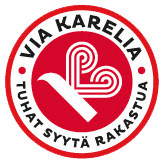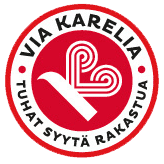Memorials of the Continuation War on Via Karelia
The Continuation War started for Finns on 25 June 1941. Given that the events of this conflict mainly took place outside the current borders of our country, apart from the defensive battle in Ilomantsi, there are far less war memorials for the Continuation War on Via Karelia than for the Winter War.
An unconventional feature of the Continuation War was the use of Soviet partisans, who purposefully attacked some twenty villages and houses along the eastern frontier and killed and detained helpless civilians. There are six memorials on Via Karelia for partisan attacks.
This site presents all the war museums on Via Karelia. Four of them are about the events of the Continuation War. They are the Paloaukea Museum in Liperi, Field Headquarters of General Raappana in Parppeinvaara, Ilomantsi, the Möhkö Ironworks Museum in Ilomantsi, and the Combatant's House in Lieksa.
The memorials for the Continuation War on Via Karelia are listed below from south to north.
The Kitee offense 10-16 July 1941
Memorial of the breakthrough battles in Kitee
Some 15km from the Kitee centre, by the Valkeavaara – Korkeakangas road, on the Mustalampi crossroads near the border guard station, there's a memorial for the Kitee breakthrough battles and the detachments of the 19th division. The memorial reads: ”From this area, the 19. division and its troops started their advancement to free Karelia in 10 July 1941”. The memorial was unveiled on 11 July 992.
A memorial stone for those fallen in the summer offense of the Continuation War
Next to the Kitee church, by the soldiers' graves, there's a memorial stone for those fallen in the summer offense of 1941 in the Continuation War. The stone reads ”Here is the temporary resting place for the Ostrobothnian soldiers of the 19th division, fallen in 1941. The Memorial Stone was erected in 1969 by national defence associations of South Otstrobothia and Kitee”.
The defensive battle of Ilomantsi in the summer of 1944
The defensive battle of Ilomantsi was very different in nature from those of the Winter War, even though the battles took place on neighbouring sites on the current Finnish ground. Many of the battle grounds on Via Karelia saw the last scenes of a long retreat during the summer of 1944.
The entire chain of events started from the great Soviet offensive on the Karelian isthmus in June 1944. Finland needed all its troops there to stop the offensive. Therefore troops in Eastern Karelia started their spontaneous retreat.
The actual defensive battle of Ilomantsi had some 35 000 Finns and an equal amount of Russians. The battle zone was 40 kilometres wide and 30 kilometres deep. The battles took place in a difficult terrain. The roads were only fit for horse carriages.
At the end of July 1944, two divisions of the 32nd Soviet army corps were approaching Ilomantsi from the Porajärvi direction. Further north, the 176th division approached, and in the south, the 289th division. These were to advance to the shores of Lake Ladoga to the rear of the Finnish VI army corps. The Soviet troops did not have extra artillery, and the poor state of the roads limited extensive use of tanks. This time, the Russians did not advance along the roads as narrow wedges, but as a wide front by building their roads as they went. The Red Army arrived on Finnish soil in Longonvaara on 21 July 1944.
The danger was imminent, and the general headquarters gave major general Erkki Raappana, commanding the 14th division, an order to also command the Finnish troops centred in Ilomantsi. This temporary formation was named Group Raappana.
The Finnish counter operation started in Ilomantsi on 30 July 1944. A battle of many "motti" situations ensued, ending in Finnish victory. The majority of Russian troops managed to escape back to their own, but they left behind a lot of ordnance to capture.
The Ilomantsi offensive was the last Soviet offensive against the Finns in the Second World War.
The Continuation War Memorials in Ilomantsi
The defensive battles of Ilomantsi took place in July and August of 1944. The battles are commemorated in a special exhibition room at the Möhkö Ironworks Museum, and in the Combatant's House (see above) in Hattuvaara, Ilomantsi. The Möhkö region has three war memorials, Hattuvaara has three, and there's one little further north at Palovaara.
Memorial of the Blackjack Brigade in Möhkö
The 21st Brigade, so called "Blackjack Brigade" has a memorial in the Möhkö village, by the Koitajoki bridge and the Möhkönkoski rapids. The memorial reads: ”The 21st Brigade fought Pro Patria from Eastern Karelia to Ilomantsi and stopped the offensive outside Möhkö in the great battles in the summer of 1944. The 21th Brigade Brothers in Arms.” Next to the memorial, there's an info board about the battles. The Memorial was unveiled to commemorate the last battles of the Continuation War in 5 August 1989.
Some 6km from Möhkö to Öykköstenvaara (road 5004), on the left side of the road there's a piece of anti-tank artillery commemorating the 21st brigade. It was placed into its original place in a restored battery in 1993. The plaque says ”Anti-tank artillery/21st BGD, Anti-tank Battery 28th July.” - 4.8.1944.
The Kaatiolampi battle grounds have old Finnish and Russian battle stations. The so called "Teppana's motti" was located in the area. The Finnish Heritage Agency has named the area a protected site. North of Teppana's motti, there are the sites of the Leminaho and the Kanninvaara motti battles.
Memorial plaque for the cavalry regiment of Häme
On Via Karelia, about 1km before the Hattuvaara village and the Combatant's House, on the eastern side of the road, a plaque attached to Hovattala cliff says: ”The cavalry regiment of Häme fought in Hattuvaara in July of 1944. the Guild of Cavalrymen”.
Memorial Plaque of the 1st cavalry regiment of Häme and the Combatant's road
North of Hattuvaara, some 1.7km on the Polvikoski road, branching off Via Karelia, by the Tiittanen's house, there's a memorial plaque on a natural stone: ”The 1st squadron of the cavalry regiment of Häme fought here on 30 July 1944”: The plaque was unveiled by Ratsumieskilta (Quild of Cavalrymen) on 30 July 1987. There's a piece of artillery next to the stone. On the battle grounds, there's a 1.5km trail, a "Combatant's road" with 13 info signs about the first cavalry regiment of Häme's battles. The trail starts by the memorial.
Memorial Plaque of the 2nd cavalry regiment of Häme
Some 2km from the first memorial toward Polvikoski, on the southern side of the road at Kukkoistenkangas, there's a memorial stone for the battles of the second squadron of the cavalry regiment of Häme, and an info board. Next to the memorial, there's a Russian grenade thrower. The memorial was unveiled by Ratsumieskilta (the Guild of Cavalrymen) on 5 August 1989.
A common memorial of the Ilomantsi battles in Palovaara
The common memorial of the Ilomantsi battles was designed by Sulo Leppänen. The memorial area is flanked by two 122mm Putilov howitzers, used in the Hattuvaara battles. The gun barrels point at the Vellivaara motti. The flat stone has a bronze plaque donated by Outokumpu Oy, that reads: ”In memory of preventive battles of the summer of 1944. Praise be to the heroes. Veteran brothers in 1981” The memorial area has a large info board illustrating the Ilomantsi battles.
The common memorial area has specific memorial plaques for the many army detachments taking part on the battles. Many of them briefly summarises their route:
Memorial for the 3rd Border Jaeger Battalion (Rj.P 3): ”1941-1944 Hanko – Syväri – Ilomantsi”
Memorial for the Dragoon Regiment of Uusimaa (URR)
Memorial of the 3rd squadron of the cavalry regiment of Häme (3./HRR). ”3/HRR fought together with JP 6, URR and JP 1 in Utrio – Teponlampi, Ilaja – Luovenjärvi, Lehmivaara, Kangasjärvi – Kalalampi and Kangasjärvi – Kitsanlampi in 30 July -4 September 1944.
JP 1 (the current Lapland's Jaeger Battalion, Sodankylä) fought around Ilomantsi from 18 July 1941 to 23 August 1941 and from 27 July 1944 to 4 September 1944.
JP 6 fought here from 26 July 1944 to 4 September 1944
Memorial of the Battery of Aura.
Battles of Rukajärvi, Lieksa
There's a memorial for the battles of the Rukajärvi direction from 4 July to 12 September 1941 in Vapaudenpuisto (Freedom park) in Lieksa.
Between the German troops in the north and the troops in Karelia there were vast forest areas, where colonel Erkki Raappana (major general in 31 December 1941) led his 14th division first to Repola and then all the way to Rukajärvi.
It crossed the national frontier on 4 July 1941 and conquered the village of Rukajärvi on 12 September 1941.
Combat road of Rukajärvi
Finland has two official "war roads". One of them is the Raate Road, a 20km road in Suomussalmi that saw battle in the Winter War. The other is the Rukajärvi Road, a battle road in the Continuation War, running 44km on the Finnish side in Lieksa. The Rukajärvi Road runs all the way to Rukajärvi, a total of 230km from the Lieksa station to Rukajärvi. The both war roads branch from Via Karelia as authorised, marked war roads.
Memorials of the partisan war near Via Karelia
Russian partisans attacked 32 civilian sites in the Continuation War. Many of these are on Via Karelia.
The memorials in Lieksa
Near Lake Pieni Ritojärvi, by the Kontiovaara road, there's a memorial stone reading ”For the victims of partisans, 30 July 1944”. There are four crosses on the stone
The Karhivaara house in Kuorajärvi has a memorial stone. The stone has 13 crosses for the four women
and nine children killed in three houses.
Another memorial for the victims of partisans is on the left side of the Suomu road, some 500m from the junction, branching off the Kivilahti – Kitsi road (5202) to the Patvinsuo National Park.
The Lieksa churchyard has a common memorial stone for 19 persons killed by Soviet partisans
Kuhmo
24 September 1943 and 24 July 1944
The new cemetery in Kuhmo (address: Kappelikuja 1) has a memorial for the victims of partisans. The memorial reads ”No freedom without an offering”.
Other memorials for the victims of Soviet partisans were unveiled by the Hirvivaarantie road (9070) in Iivantiira on 24 July 1994, and by the Viiksimo border guard station (Viiksimontie road) on 2 July 1995. Both memorials were designed by Kauko Haverinen.
Border villages of Suomussalmi, 26 June 1943
Partisans attacked border villages of Suomussalmi: Viianki, Hyry and Malahvia, on 26 June 1943. In Viianki, a stove of a destroyed house serves as a memorial, and other memorials were unveiled in Hyry ja Malahvia on 4 July 1993. On a concrete slate, there is a plaque identifying the victims.
Lämsänkylä village in Kuusamo, 18 July 1943
Lämsänkylä lost one of their own, and another did not return from captivation, when the prisoners were exchanged after the war. The memorial in Lämsänkylä was unveiled on 22 July 1990.
Murtovaara in Kuusamo, 5 July 1942
Partisans attacked two passenger cars. Toini Jännes, chairperson of Sotilaskotiliitto (running canteens in military bases and operations), Greta Palojärvi and Faini Aflecht were killed in the attack. Also their drivers, corporals V.I.Moilanen and T.I.Rossinen died. Another passenger car managed to turn away from the attack site.
The memorial stone is by the Murtovaara – Hossa road (913) some seven kilometres south from Murtovaara. The memorial erected by the Sotilaskotiliitto says ”There is no greater love than to give one's life for a friend”.
Hautajärvi in Salla
Partisans captured and killed five civilians making hay in Kiviaava on 15 July 1943. There's a memorial stone on Via Karelia, in Aholanvaara as a part of a tank obstacle of the Salpa Line fortification. The memorial was erected by the Hautajärvi village committee. Another memorial for the victims of Kiviaava is on the capture site.




